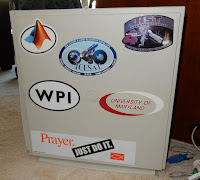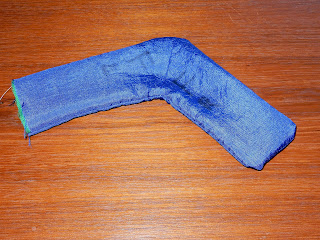Yes, that's a beige computer with a CRT monitor. That's what computers were like in 2000. Roberta was a Dell desktop and came with a 20GB hard drive loaded with Windows 98. She had a CD-ROM (not writable) drive, a Zip drive, and a floppy drive! When I got to school, and the IT folks were helping get everyone's computers set up on the network, they had to assign the computers a name. They asked what I wanted to name my computer, and I chose Roberta after one of the characters in "Firestar" by Michael Flynn, one of my favorite novels at the time. Roberta was this tough, angsty, Goth, poet teenager, who my alter-ego totally identified with. And so I named my computer after her.


Roberta went through my changes over the years I was in college. I upgraded from Windows 98 to Windows 2000 and eventually to Windows XP. And this was back in the days when upgrading your operating system wasn't just a quick download. It meant backing up all your files because the install from CDs would wipe your hard drive, installing the OS, which took a long time, then reinstalling all your files.
A friend gave me a small, 4GB hard drive, helped me install Redhat Linux on it, and taught me how to set up my machine to dual-boot. That saved my butt when I installed software that came with one of my textbooks that turned out to be incompatible with Windows 2000 and crashed my system. With dual-booting, I was still able to boot into my Linux drive and access my files to back them up before reinstalling Windows. Later, I replaced the original 20GB hard drive with a bigger, 80GB drive.
One of my sister's grad school friends gave me an old DVD drive he didn't need anymore, so then I could watch movies on my computer, which was exciting. At another point, I replaced the old CD-ROM drive with a CD read-writable drive, so I could burn lots of music CDs to play in my car.
The first time I opened up my computer, I forget what it was for, probably to add a hard drive, I was so scared. Excited, and scared. As an electrical engineering major, I was super excited to learn about the insides of my computer, especially since I was at school with tons of guys who had already built their own computers from scratch. And I was terrified of breaking it. But I had friends who helped me and taught me, and I didn't break anything, and I learned how to figure things out. I learned practical things that weren't taught in any of my classes.
Now, at home, I prefer laptops, small, portable, grab it and sit on the couch and write emails or scan Facebook or whatever. But you can't take them apart and upgrade them the same way you can a desktop because everything has to be packed in there just so.
I've kept Roberta for 16 years. For the past several, she's just sat on my desk, collecting dust and various unimplemented plans. I've decided that I might like to actually use my desk sometimes, on the rare occasions when I work from home, and so it was time for Roberta to go, to make room for new things. Because sometimes, you can hold onto the memories, while letting go of the things, and that can be OK.











